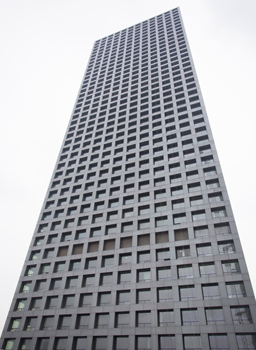Zachary Formwalt
Three Exchanges
November 27, 2014–January 25, 2015
Stedelijk Museum Bureau Amsterdam
Rozenstraat 59
Amsterdam
The Netherlands
Stedelijk Museum Bureau Amsterdam presents the solo exhibition Zachary Formwalt – Three Exchanges. In three recent video installations, Zachary Formwalt focuses on the architecture of the new Shenzhen Stock Exchange and the Amsterdam stock and commodities exchange designed at the end of the 19th century by the socialist architect H.P. Berlage. The three installations examine a fundamental issue surrounding financial trade: whereas financial transactions seem to dictate our economy so that their effects can be felt everywhere, the activity of trading itself has become increasingly remote and seems to exclude the possibility of any kind of actual human encounter. The architecture of the stock exchanges serves as a starting point to a profound investigation into the limitations of photography to represent capital and into the interrelationships between financial capitalism and image making.
Zachary Formwalt – Three Exchanges in SMBA is the third exhibition in the series of the Stedelijk Museum Amsterdam’s Global Collaborations programme. The exhibition will be presented at the Museum of Contemporary Art in Belgrade (MoCAB) in February 2015.
In the oldest of his three installations, Unsupported Transit (2011), Formwalt concentrates on the construction site and the construction work on the outside of the new stock exchange in the Chinese city of Shenzhen, designed by Rem Koolhaas’s Office for Metropolitan Architecture. Shenzhen has a special status as an economic zone where the authorities allow the system of the free market to run its course. The video diptych In Light of the Arc (2013) registers the materialisation of the same stock exchange, which is paradoxically marked by an increasing level of abstraction. Since the stock trade is now entirely controlled by information technology and advanced algorithms, the trade floor itself, with its iconic golden bell, now serves only a ceremonial purpose. In the third installation, An Unknown Quantity, realised this year, Formwalt turns the camera to H.P. Berlage’s exchange in Amsterdam. How could Berlage, known for socialist-driven housing solutions for Amsterdam’s working class, match his idealism with the commission of designing this palace of capitalism?
Formwalt’s work has become specifically topical due to the worldwide credit crisis of 2007–08 and the impact of finance and the mechanics of financial capitalism on our economies and our social lives. An important and recurrent concern in Formwalt’s work is that material outcomes of economic and social processes, such as architectural constructions, can be captured and visualised, but the very financial processes underlying this outcome remain elusive. His work uses images and voice-over to launch a comprehensive investigation of the complex entanglements of history, capitalism and image making. By juxtaposing images and sounds, Formwalt demonstrates that history, in some ways similar to financial transactions, appears to be insubstantial and almost transparent, despite the fact that various consequences can be observed through the lens.
Publication
Zachary Formwalt – Three Exchanges will be accompanied by an SMBA Newsletter with an introduction by Jelle Bouwhuis, head of SMBA. This newsletter is bilingual (Dutch/English) and available for free at the exhibition, and as a PDF on the SMBA website. The publication Zachary Formwalt – Three Exchanges will appear in conjunction with the exhibition in MoCAB. It features contributions by Jelle Bouwhuis (head of SMBA and curator of the exhibition) and Zoran Erić (head curator at MoCAB), Dr Eric de Bruyn (art historian and media theorist, lecturer at Leiden University) and Joshua Simon (director of Museums of Bat Yam, Israel). It also contains research materials such as texts and photography that were used in the context of the three video installations.
Global Collaborations / Zachary Formwalt –Three Exchanges is generously supported by principal benefactors Stichting Ammodo and Mondriaan Fund and made possible with additional support from Outset Netherlands and the Amsterdam Fund for the Arts.

